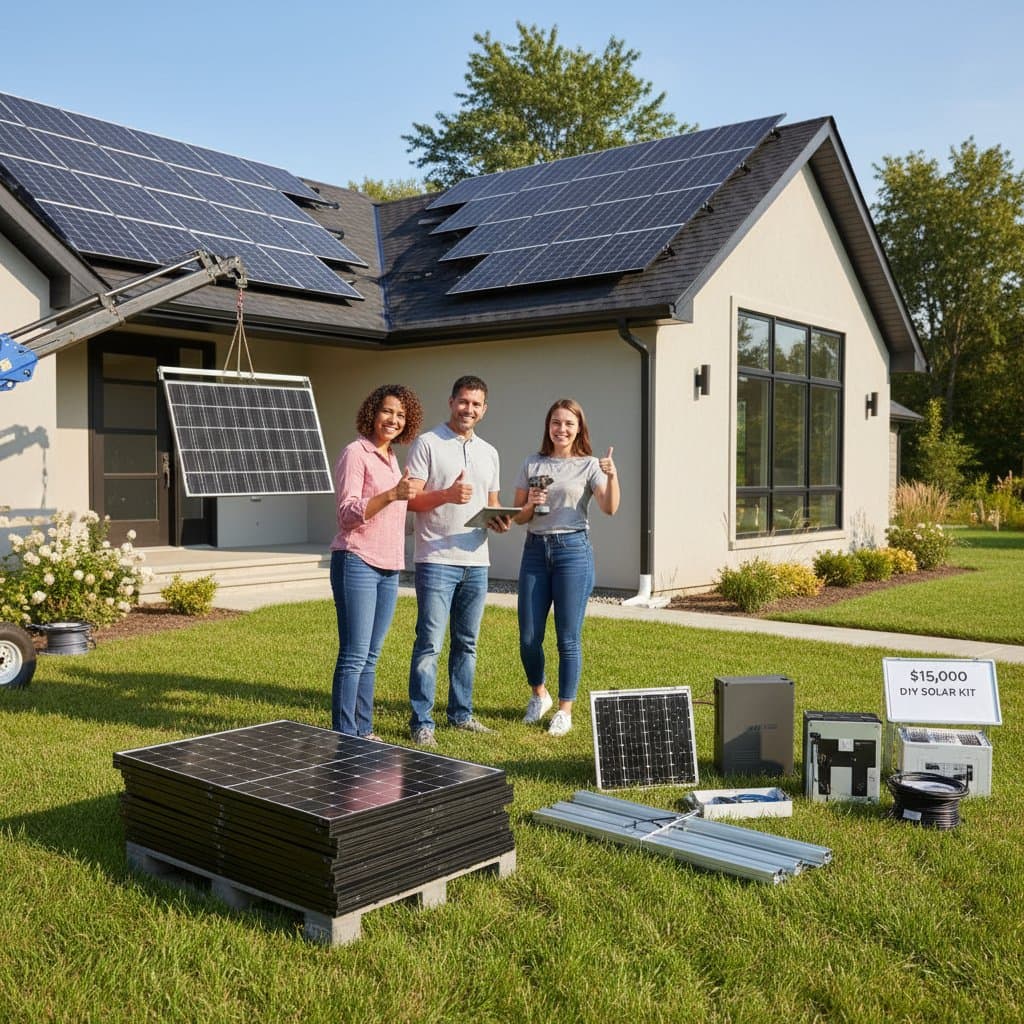Achieve Substantial Savings with DIY Solar Installations at $15,000
Homeowners often express enthusiasm for solar energy yet pause upon encountering quotes exceeding $25,000. Fortunately, solar adoption becomes a feasible personal endeavor for individuals adept with tools and meticulous planning. Contemporary DIY solar kits enable the deployment of a complete system for about $15,000, transforming an apparently unattainable goal into a viable financial commitment.
Professional electrician credentials prove unnecessary for numerous project segments. Required instead are diligence, dependable resources, and a precise grasp of self-managed tasks versus those necessitating licensed oversight or integration.
Reasons for the Rise in DIY Solar Adoption
Cost reduction stands as the primary motivator for homeowners pursuing self-installation. Labor charges and administrative expenses typically constitute 30 to 50 percent of a comprehensive solar proposal. A $15,000 self-managed setup supplants a professional installation potentially surpassing $30,000. These funds remain with the owner while delivering identical renewable energy benefits from the panels.
Self-installation grants enhanced oversight. Owners select preferred panel manufacturers, inverter configurations, and array arrangements. Current kits feature pre-assembled wiring with straightforward plug interfaces that streamline construction. Digital design platforms assist in scaling the system to align with household consumption patterns.
Fundamentals of a DIY Solar System
Solar panels transform sunlight into direct current electricity. An inverter converts this to alternating current compatible with household appliances. The assembly integrates with the primary electrical panel, compensating for grid-drawn power. Excess production reverses the utility meter under net metering policies.
A standard residence accommodates a 7-kilowatt array. In areas yielding roughly 1,300 kilowatt-hours per kilowatt annually, such a system generates approximately 9,100 kilowatt-hours per year. With electricity priced at 24 cents per kilowatt-hour, annual offsets reach about $2,180 prior to any surcharges. Consequently, a $15,000 investment recoups in approximately seven years, contingent on regional tariffs and available rebates.
Components Included in a DIY Solar Kit
Contemporary solar kits generally encompass:
- High-efficiency panels equipped with integrated connectors
- Mounting frameworks and rooftop fasteners
- String inverters or microinverter arrays
- Wiring assemblies and junction enclosures
- Safety interrupters and grounding apparatus
- Monitoring applications or software interfaces
Certain kits incorporate battery storage for resilience, although this elevates expenses. Grid-connected configurations sans batteries suit novices, offering simplicity and affordability.
Step-by-Step Installation Process and Support Resources
A DIY initiative does not imply solitary effort. Most participants manage panel fixation, preliminary wiring pathways, and device configuration. Licensed electricians or authorities finalize grid ties to uphold safety protocols and regulatory adherence.
Essential procedures comprise:
- Site Evaluation. Assess roof alignment, obstruction levels, and available area. Optimal performance arises from south-oriented roofs with scant shading.
- System Design and Permitting. Employ web-based estimators to validate capacity and furnish schematic diagrams for authorization.
- Mounting and Wiring. Install support rails, affix panels, and link conduits per kit directives.
- Review and Grid Integration. Professionals examine installations prior to utility linkage.
- Performance Tracking. Initiate monitoring tools to observe generation and financial gains.
For those apprehensive about electrical tasks, engage an electrician for targeted hours. Allocating a few hundred dollars for verification ensures tranquility.
Detailed Cost Analysis and Incentive Opportunities
A $15,000 kit may feature nine kilowatts of panels at approximately $1.65 per watt. Allocate an additional $1,000 for approvals, implements, and specialist labor. Federal tax credits alongside regional rebates substantially diminish outlays. Participants frequently reclaim 30 percent or greater via incentives, lowering net expenditure to around $10,000.
Across 25 years, the array potentially yields over 200,000 kilowatt-hours, offsetting up to $48,000 in utility bills at prevailing rates. Factoring in gradual efficiency decline and periodic servicing, profitability remains robust.
Upkeep Requirements and System Durability
DIY solar arrays demand limited maintenance. Routinely cleanse panels, inspect cabling yearly, and verify output against projections via monitoring. Inverters occasionally require substitution midway through the lifecycle, typically after 10 to 15 years. Panels benefit from minimum 20-year guarantees, with many sustaining output far longer.
Enhancing Daily Routines with Solar Integration
Upon system activation, amplify efficiencies through behavioral adjustments. Operate energy-intensive devices amid peak sunlight, adopt LED illumination, and install intelligent climate controls. Such modifications maximize self-consumption of generated power over grid exportation. Incremental actions amplify the investment's overall impact.
Practical Actions to Launch Your Project
- Compile 12 months of utility statements.
- Calculate average daily consumption.
- Leverage online calculators for system sizing.
- Solicit proposals from multiple kit providers.
- Identify mandatory professional validations.
- Plan deployment during favorable weather periods.
Every installation fosters community expertise and assurance. Beyond fiscal advantages, DIY solar empowers energy autonomy, demonstrating renewable viability for everyday homes.
Frequently Asked Questions
What skill level is required for a DIY solar installation? Basic familiarity with tools suffices for mounting and wiring; electrical expertise proves beneficial but not essential, as kits provide detailed manuals.
Are DIY installations eligible for tax incentives? Yes, federal and state programs apply equally to self-managed projects, provided they meet code standards and undergo inspections.
How long does a typical DIY install take? Most complete in 2 to 5 days, depending on roof access and weather, with professional steps adding 1 to 2 days.
What if I encounter issues during installation? Kits include support hotlines; local solar groups or forums offer peer advice, and partial professional hires address complexities.
